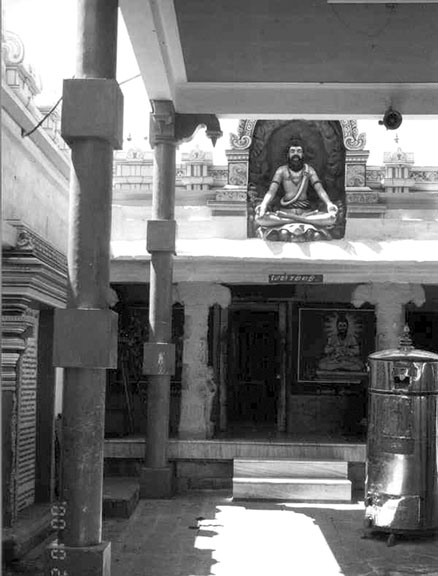After the loss of his wife, Ramu lived in a room in his father’s house and later in an eight-foot square hut in a field on his family’s property. There, he devoted himself entirely to religious study and meditation and became more and more introspective. Next to the hut, he had planted a small flower garden and picked flowers for the morning puja. The rest of the day was spent in meditation and the study of books by Saint Pattinathar, a great renunciate; Sri Ramakrishna Paramahamsa, Saint Ramalingam, Sri Swami Vivekananda and Sri Swami Sivananda. To keep his body fit, he practiced Hatha Yoga asanas, physical postures designed to bring flexibility to the spine and overall perfect health. His diet was austere, limited to one meal a day at noon consisting of kitcheri, a mixture of rice and dal. This strict regimen continued for almost a year. Ramu shared his small space with a number of snakes and once found a family of scorpions living less than a foot from his bed.
In his flower garden home, during meditation Ramu’s early spiritual experiences manifested. As he carefully concentrated on his beloved deity, the Goddess Parvati, he felt the small room suddenly glow with light and fill with her unearthly presence. She appeared shining before him. With her was Lord Subramanya. After that Ramu often had such darshan (visions) in the small hut.

Sri Sadhu Swamigal, Palani
It was a good situation for introspection and meditation, but Ramu began to feel the need to further explore spiritual life outside those particular confines. As he considered this, he naturally thought of Sri Sadhu Swamigal, one of the main holy men who had frequented the family home during Ramu’s boyhood. In fact, Sadhu Swamigal was like the family Guru and had given mantra initiation to Srimati Velammai. He was a great upasika or tantric yogi, one who uses geometrical forms or yantras, as well as certain mantras, mudras, and cleansing practices during the course of worship to invoke the presence of a particular deity. Ultimately the upasika receives that presence or vision within.
Sadhu Swamigal had an ashram on the side of Palani Hill. That is where Ramu went for the next stage of his spiritual journey. The holy place called Palani is a hill temple dedicated to Lord Muruga with the name Palani Andavar. For many centuries it has been a place of pilgrimage and meditation for saints and seekers. Many siddhas lived and attained samadhi in this holy place, and sincere seekers can feel their presence even today. Ramu and his fellow sadhus often saw visions of these great siddha purushas (personalities of spiritual accomplishment) as they went to and from worship or meditation.
Siddhas are yogis who have supernatural powers, called siddhis. One great siddha named Bhogar had established the Palani Temple and effected its construction. He was a great alchemist and made the Palani deity from a special preparation. Gathering nine poisonous chemicals, he mixed them together in the exact proportion that would make them counteract the poisonous effects. This mixture is called navapaashaanam (nine poisonous chemicals). From it he constructed the deity. During worship there was the traditional pouring of milk, honey, rose water, sandalwood paste and mashed bananas over the deity. Devotees then took a bit of the resulting mixture as prasad (consecrated food or objects). Worship of this deity still continues, and many have claimed that because of the medicinal properties of the deity their hopeless illnesses were cured by taking this prasad.
Often Ramu sat and meditated at Bhogar’s tomb, “Bhogar Samadhi,” after his regular worship. One day, repeating his mantra, Ramu had a vision. Bhogar appeared clearly before him and began to repeat the mantra also. He placed his right palm over Ramu’s head. The devotee lost all awareness of his body and fell into a “conscious sleep.” Peace and bliss surrounded him. The physical world no longer existed.

Bhogar Samadhi, Palani Hill Temple
After one half-hour, he slowly returned to normal consciousness. Bhogar’s form was no longer before him, but Ramu felt he had received Bhogar’s blessing and initiation.
Ramu eventually left Palani Hill, to continue on a pilgrimage and further study with some of the great South Indian saints and sages.
“By renouncing the world, you don’t lose anything. Once you give yourself to others, all others will give themselves to you. In the beginning of this life, people often said to me, “Why are you renouncing? You have thrown away your house, your wealth, everything. What are you going to gain?” I would tell them, “It may look like I am giving up something, but I know that I will gain everything.” —Swami Satchidananda

Recent Comments